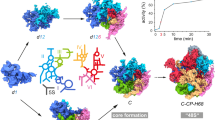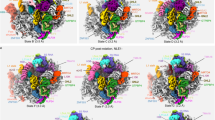Abstract
RACK1 serves as a scaffold protein for a wide range of kinases and membrane-bound receptors. It is a WD-repeat family protein and is predicted to have a β-propeller architecture with seven blades like a Gβ protein. Mass spectrometry studies have identified its association with the small subunit of eukaryotic ribosomes and, most recently, it has been shown to regulate initiation by recruiting protein kinase C to the 40S subunit. Here we present the results of a cryo-EM study of the 80S ribosome that positively locate RACK1 on the head region of the 40S subunit, in the immediate vicinity of the mRNA exit channel. One face of RACK1 exposes the WD-repeats as a platform for interactions with kinases and receptors. Using this platform, RACK1 can recruit other proteins to the ribosome.
This is a preview of subscription content, access via your institution
Access options
Subscribe to this journal
Receive 12 print issues and online access
$189.00 per year
only $15.75 per issue
Buy this article
- Purchase on Springer Link
- Instant access to full article PDF
Prices may be subject to local taxes which are calculated during checkout





Similar content being viewed by others
References
McCahill, A., Warwicker, J., Bolger, G.B., Houslay, M.D. & Yarwood, S.J. The RACK1 scaffold protein: a dynamic cog in cell response mechanisms. Mol. Pharmacol. 62, 1261–1273 (2002).
Ron, D. et al. Cloning of an intracellular receptor for protein kinase C: a homolog of the β subunit of G proteins. Proc. Natl. Acad. Sci. USA 91, 839–843 (1994).
Rodriguez, M.M., Ron, D., Touhara, K., Chen, C.H. & Mochly-Rosen, D. RACK1, a protein kinase C anchoring protein, coordinates the binding of activated protein kinase C and select pleckstrin homology domains in vitro. Biochemistry 38, 13787–13794 (1999).
Chang, B.Y., Conroy, K.B., Machleder, E.M. & Cartwright, C.A. RACK1, a receptor for activated C kinase and a homolog of the β subunit of G proteins, inhibits activity of src tyrosine kinases and growth of NIH 3T3 cells. Mol. Cell. Biol. 18, 3245–3256 (1998).
Chang, B.Y., Harte, R.A. & Cartwright, C.A. RACK1: a novel substrate for the Src protein-tyrosine kinase. Oncogene 21, 7619–7629 (2002).
Liliental, J. & Chang, D.D. Rack1, a receptor for activated protein kinase C, interacts with integrin β subunit. J. Biol. Chem. 273, 2379–2383 (1998).
Yaka, R. et al. NMDA receptor function is regulated by the inhibitory scaffolding protein, RACK1. Proc. Natl. Acad. Sci. USA 99, 5710–5715 (2002).
Sondek, J. & Siderovski, D.P. Gγ-like (GGL) domains: new frontiers in G-protein signaling and β-propeller scaffolding. Biochem. Pharmacol. 61, 1329–1337 (2001).
Steele, M.R. et al. Identification of a surface on the β-propeller protein RACK1 that interacts with the cAMP-specific phosphodiesterase PDE4D5. Cell Signal. 13, 507–513 (2001).
Link, A.J. et al. Direct analysis of protein complexes using mass spectrometry. Nat. Biotechnol. 17, 676–682 (1999).
Ceci, M. et al. Release of eIF6 (p27BBP) from the 60S subunit allows 80S ribosome assembly. Nature 426, 579–584 (2003).
Chantrel, Y., Gaisne, M., Lions, C. & Verdiere, J. The transcriptional regulator Hap1p (Cyp1p) is essential for anaerobic or heme-deficient growth of Saccharomyces cerevisiae: genetic and molecular characterization of an extragenic suppressor that encodes a WD repeat protein. Genetics 148, 559–569 (1998).
Shor, B., Calaycay, J., Rushbrook, J. & McLeod, M. Cpc2/RACK1 is a ribosome-associated protein that promotes efficient translation in Schizosaccharomyces pombe. J. Biol. Chem. 278, 49119–49128 (2003).
Inada, T. et al. One-step affinity purification of the yeast ribosome and its associated proteins and mRNAs. RNA 8, 948–958 (2002).
Baum, S., Bittins, M., Frey, S. & Seedorf, M. Asc1p, a WD40-domain containing adaptor protein, is required for the interaction of the RNA-binding protein Scp160p with polysomes. Biochem. J. 380, 823–830 (2004).
Angenstein, F. et al. A receptor for activated C kinase is part of messenger ribonucleoprotein complexes associated with polyA-mRNAs in neurons. J. Neurosci. 22, 8827–8837 (2002).
Li, A.M., Watson, A. & Fridovich-Keil, J.L. Scp160p associates with specific mRNAs in yeast. Nucleic Acids Res. 31, 1830–1837 (2003).
Gavin, A.C. et al. Functional organization of the yeast proteome by systematic analysis of protein complexes. Nature 415, 141–147 (2002).
Spahn, C.M. et al. Structure of the 80S ribosome from Saccharomyces cerevisiae—tRNA-ribosome and subunit-subunit interactions. Cell 107, 373–386 (2001).
Wimberly, B.T. et al. Structure of the 30S ribosomal subunit. Nature 407, 327–339 (2000).
Brodersen, D.E., Clemons, W.M. Jr., Carter, A.P., Wimberly, B.T. & Ramakrishnan, V. Crystal structure of the 30 S ribosomal subunit from Thermus thermophilus: structure of the proteins and their interactions with 16S RNA. J. Mol. Biol. 316, 725–768 (2002).
Frank, J. et al. SPIDER and WEB: processing and visualization of images in 3D electron microscopy and related fields. J. Struct. Biol. 116, 190–199 (1996).
Spahn, C.M. et al. Domain movements of elongation factor eEF2 and the eukaryotic 80S ribosome facilitate tRNA translocation. EMBO J. 23, 1008–1019 (2004).
Spahn, C.M. et al. Cryo-EM visualization of a viral internal ribosome entry site (IRES) bound to human 40S and 80S ribosomes: the IRES functions as an RNA-based translation factor. Cell 118, 465–475 (2004).
Morgan, D.G., Menetret, J.F., Neuhof, A., Rapoport, T.A. & Akey, C.W. Structure of the mammalian ribosome-channel complex at 17 Å resolution. J. Mol. Biol. 324, 871–886 (2002).
Halic, M. et al. Structure of the signal recognition particle interacting with the elongation-arrested ribosome. Nature 427, 808–814 (2004).
Dube, P. et al. Correlation of the expansion segments in mammalian rRNA with the fine structure of the 80 S ribosome; a cryoelectron microscopic reconstruction of the rabbit reticulocyte ribosome at 21 Å resolution. J. Mol. Biol. 279, 403–421 (1998).
Bates, P.A., Kelley, L.A., MacCallum, R.M. & Sternberg, M.J. Enhancement of protein modeling by human intervention in applying the automatic programs 3D-JIGSAW and 3D-PSSM. Proteins 5 (suppl.), 39–46 (2001).
Lambright, D.G. et al. The 2.0 Å crystal structure of a heterotrimeric G protein. Nature 379, 311–319 (1996).
Rath, B.K. et al. Fast 3D motif search of EM density maps using a locally normalized cross-correlation function. J. Struct. Biol. 144, 95–103 (2003).
Bates, P.A. & Sternberg, M.J. Model building by comparison at CASP3: using expert knowledge and computer automation. Proteins 3 (suppl.), 47–54 (1999).
Chang, B.Y., Chiang, M. & Cartwright, C.A. The interaction of Src and RACK1 is enhanced by activation of protein kinase C and tyrosine phosphorylation of RACK1. J. Biol. Chem. 276, 20346–20356 (2001).
Chicurel, M.E., Singer, R.H., Meyer, C.J. & Ingber, D.E. Integrin binding and mechanical tension induce movement of mRNA and ribosomes to focal adhesions. Nature 392, 730–733 (1998).
Steward, O. & Schuman, E.M. Compartmentalized synthesis and degradation of proteins in neurons. Neuron 40, 347–359 (2003).
Shevchenko, A., Matthias, W., Ole, V. Mass spectrometric sequencing of proteins from silver-stained polyacrylamide gels. Anal. Chem. 68, 850–858 (1996).
Keough, T., Lacey, M.P. & Youngquist, R.S. Derivatization procedures to facilitate de novo sequencing of lysine-terminated tryptic peptides using postsource decay matrix-assisted laser desorption/ionization mass spectrometry. Rapid Commun. Mass Spectrom. 14, 2348–2356 (2000).
Sottrup-Jensen, L. A low-pH reverse-phase high-performance liquid chromatography system for analysis of the phenylthiohydantoins of S-carboxymethylcysteine and S-carboxyamidomethylcysteine. Anal. Biochem. 225, 187–188 (1995).
Wagenknecht, T., Grassucci, R. & Frank, J. Electron microscopy and computer image averaging of ice-embedded large ribosomal subunits from Escherichia coli. J. Mol. Biol. 199, 137–147 (1988).
Frank, J., Penczek, P., Agrawal, R.K., Grassucci, R. & Heagle, A. Three-dimensional cryoelectron microscopy of ribosomes. Methods Enzymol. 317, 276–291 (2000).
Zhu, J., Penczek, P.A., Schröder, R. & Frank, J. Three-dimensional reconstruction with contrast transfer function correction from energy-filtered cryoelectron micrographs: procedure and application to the 70S Escherichia coli ribosome. J. Struct. Biol. 118, 197–219 (1997).
Malhotra, A. et al. Escherichia coli 70 S ribosome at 15 Å resolution by cryo-electron microscopy: localization of fMet-tRNAfMet and fitting of L1 protein. J. Mol. Biol. 280, 103–116 (1998).
Gabashvili, I. et al. Solution structure of the E. coli 70S ribosome at 11.5 Å resolution. Cell 100, 537–549 (2000).
Chothia, C. & Lesk, A.M. The relation between the divergence of sequence and structure in proteins. EMBO J. 5, 823–826 (1986).
Carson, M. Ribbons 2.0. J. Appl. Crystallog. 24, 958–961 (1991).
Acknowledgements
We thank J. Enghild and I. Thøgersen, as well as C. Oxvig and S. Glerup, for mass spectrometry data, T. Heick Jensen for providing the S. cerevisiae RACK1-deleted strain, and B. Jensen for the T. lanuginosus strain. We are grateful to L. Kristensen for help with N-terminal sequencing. We thank M. Watters for preparing the illustrations, W. Li and B. Rath for their advice on the use of the fitting program and D. Lalor for her help with three-dimensional image processing. This work was supported by Howard Hughes Medical Institute and US National Institutes of Health grants R37 GM29169, R01 GM55440, P41 RR01219 and NSF BIR 9219043 (to J.F.), and by an Ole Rømer research grant and the Danish Research Council. the Human Frontier Science Program and the EMBO Young Investigator Program (to P.N.).
Author information
Authors and Affiliations
Corresponding authors
Ethics declarations
Competing interests
The authors declare no competing financial interests.
Supplementary information
Supplementary Fig. 1
Purification of T. lanuginosus 80S ribosomes on hydrophobic column. (PDF 118 kb)
Supplementary Fig. 2
Fourier Shell Correlation (FSC) curves for three ribosome samples. (PDF 56 kb)
Supplementary Fig. 3
Sequence alignment for the S. cerevisiae RACK1 protein and G-β protein. (PDF 116 kb)
Supplementary Fig. 4
Stereo view of the homolog model fitted into the cryo-EM density of the S. cerevisiae 11.7 Å 80S map in the 40S subunit head region. (PDF 138 kb)
Supplementary Fig. 5
Interaction of RACK1 with ribosomal components. (PDF 223 kb)
Supplementary Table 1
Mass spectrometry identification of RACK1 in T. lanuginosus 80S ribosome. (PDF 23 kb)
Rights and permissions
About this article
Cite this article
Sengupta, J., Nilsson, J., Gursky, R. et al. Identification of the versatile scaffold protein RACK1 on the eukaryotic ribosome by cryo-EM. Nat Struct Mol Biol 11, 957–962 (2004). https://doi.org/10.1038/nsmb822
Received:
Accepted:
Published:
Issue Date:
DOI: https://doi.org/10.1038/nsmb822



